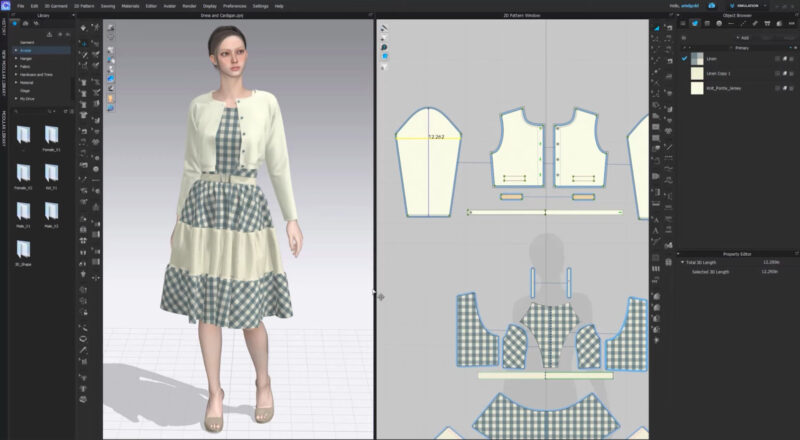In today’s garment-making and designing business, whether it is a small, medium, or large-scale garment business, a computer-aided design (CAD) system is a must-have software. CAD software solutions help clothes manufacturers and brands increase cutting room productivity, pattern accuracy, and overall fit.
If you are a fashion designer or styler, or you need to design patterns for your own apparel business, you need to master these digital tools. This article will assist you in learning more about pattern-making software.
1. Lectra
Lectra’s digital solutions are a game-changer in the fashion industry. By integrating software, hardware, services, and data, they provide a holistic approach to pattern-making.
Kaledo Style
Kaledo Style, one of Lectra’s pattern-making tools, assists designers at important stages of the fashion design process, from stylized drawings to technical designs. At all stages of concept formulation and development, it allows design teams to generate boards, line drawings, and mini-bodies while increasing efficiency.
Benefits of Lectra
- Efficiency: With tools like Kaledo Style, designers can streamline their processes, reducing the time taken from concept to final design.
- Integration: Lectra’s solutions seamlessly integrate various aspects of the design process, ensuring consistency and accuracy.
2. Tuka CAD
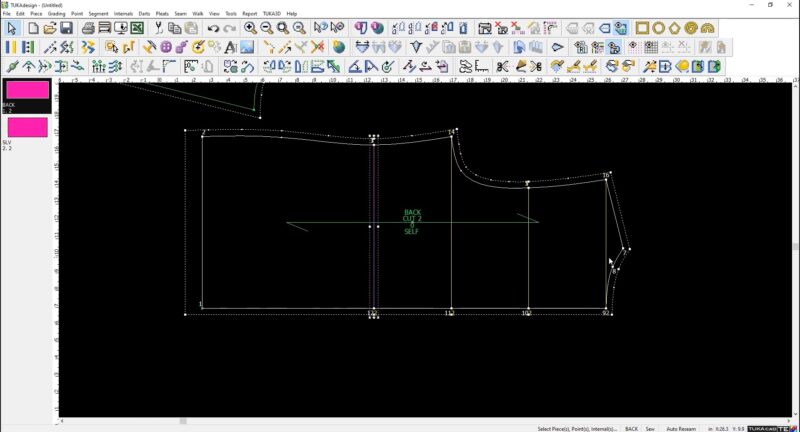
Tuka CAD stands out for its comprehensive functionality in 2D CAD pattern making, grading, and marker making.
Features of Tuka CAD
Tuka CAD is a fashion CAD pattern-creating software with comprehensive functionality and process engineering to enable accurate pattern building, bespoke grading standards, and marker nesting for any style. Every tool also has audio/video support. Instead of changing the patterns one by one, Tuka CAD allows you to easily change the numbers in your measuring chart.
Advantages of Using Tuka CAD
- Flexibility: The software allows for easy modifications, ensuring that designers can adapt to changing requirements.
- Audio/Video Support: This unique feature ensures that users can get real-time guidance, making the design process smoother.
3. Optitex
Optitex is a leading name when it comes to end-to-end fashion design software, especially for diverse industries like fashion, apparel, automobiles, and upholstery.
3D Prototyping with Optitex
For fashion, apparel, automobiles, and upholstery, Optitex offers end-to-end fashion design software, including 2D CAD/CAM pattern design and 3D prototypes. A suite of 3D tools that present virtual samples in an innovative 3D digital environment that allows you to construct your garment and make quick modifications at the touch of a button, with photorealistic rendering for a true-to-life visualization, driven by photorealistic rendering.
Why Optitex Stands Out
- Innovative 3D Tools: The software provides a realistic 3D environment, making design visualization more accurate.
- Photorealistic Rendering: This ensures that the designs are as close to the real thing as possible, reducing the need for multiple prototypes.
4. Gerber AccuMark
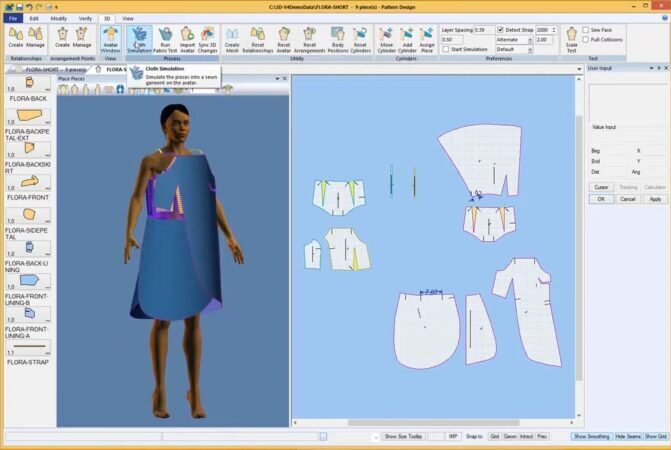
Gerber Technology’s AccuMark platform is more than just software; it’s a complete ecosystem for fashion designers.
Features of Gerber AccuMark
Gerber Technology’s AccuMark platform is a fully integrated suite of software products to take you from design to completion. The smart pattern design, grading, marker making, and production planning platform allows you to visualize your design, create accurate patterns, and optimize your markers with a suite of software solutions that seamlessly connect data.
Its 3D design module helps you visualize your samples in 3D with the click of a button.
Benefits of Using Gerber AccuMark
- Integrated Suite: The platform offers a range of tools, ensuring that designers have everything they need in one place.
- 3D Design Module: This feature allows for better visualization, ensuring that the final product matches the designer’s vision.
5. Richpeace
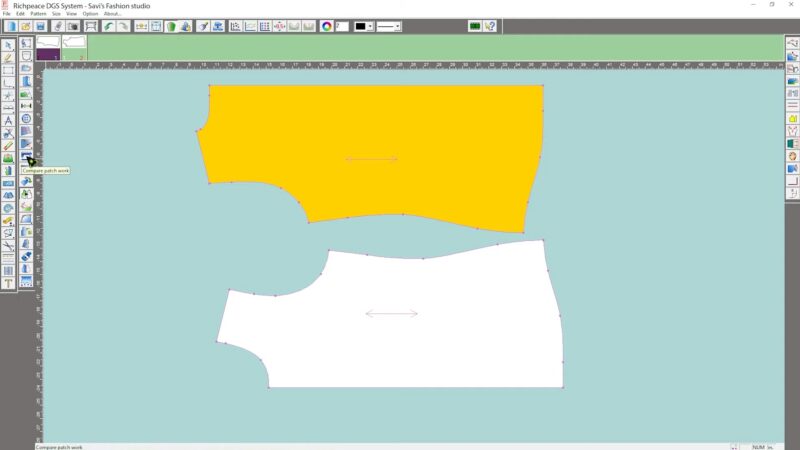
Richpeace is not just limited to fashion and apparel but extends its intelligent cutting and sewing technology to other industries like home textiles, bags, and shoes.
Richpeace’s Garment CAD Design Center
Richpeace offers intelligent cutting and sewing technology used in fashion, apparel, home textiles, bags, shoe making, and more. Its Garment CAD Design Center consists of various software programs most of which are free to download.
You can design patterns and grading in computers or digitize existing patterns into computers. The down-content function in the grading part calculates the amount of filling in the entire piece or component, making it easier for you to calculate the amount and cost.
Why Choose Richpeace?
- Versatility: The software is suitable for a range of industries, making it a valuable tool for designers in various fields.
- Cost Calculation: The in-built functions allow designers to estimate costs, ensuring that projects stay within budget.
6. Etelestia
Etelestia is unique as it combines CAD software with an online learning platform, making it perfect for budding designers.
Etelestia’s CAD System
Etelestia is a CAD and fashion learning platform, which offers both online courses and CAD software. Its apparel CAD system includes pattern-making, grading, cutting, and fashion-designing tools.
It combines a set of easy-to-learn CAD tools and functions, which allows you to create your own blocks and styles, build up your own style library, modify and adjust existing blocks, and create fully professional collections. The software comes with built-in help and ready examples features.
Benefits of Etelestia
- Learning and Designing: The platform offers both online courses and CAD software, ensuring that users can learn and design simultaneously.
- Built-in Help: The software is user-friendly, with ready examples and help features to guide designers.
7. PAD System
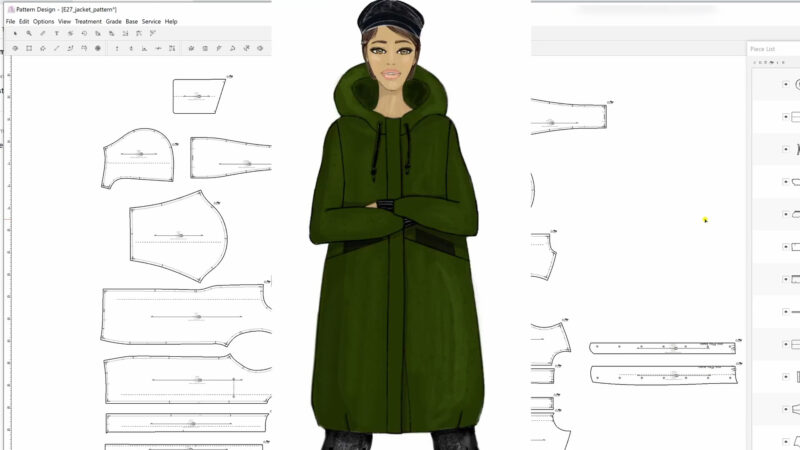
The PAD System is known for its advanced capabilities, making it a top choice for professionals in the fashion industry.
Features of the PAD System
PAD System is a sophisticated and full-featured CAD pattern-making software. Its Pattern Design system includes advanced capabilities such as Clone, Made-To-Measure, and others that enable you to use the most powerful CAD tools for pattern design, pattern treatment, grading, bulk customization, and custom-made tailoring.
Why PAD System is a Top Choice
- Advanced Capabilities: The software offers features like Clone and Made-To-Measure, ensuring precision in design.
- Customization: Whether it’s bulk customization or custom-made tailoring, the PAD System has got you covered.
8. StyleCAD
StyleCAD has been a prominent name in the fashion industry for its intuitive user interface and powerful pattern design capabilities.
Features of StyleCAD
StyleCAD offers a comprehensive suite of tools for pattern design, grading, and marker making. With its intuitive drag-and-drop interface, designers can easily manipulate patterns, adjust grading, and optimize fabric usage.
Additionally, StyleCAD’s advanced algorithms ensure precision and accuracy in every design.
Benefits of Using StyleCAD
- User-Friendly Interface: The drag-and-drop functionality makes it easy for designers to create and adjust patterns without the need for extensive training.
- Precision: With advanced algorithms, StyleCAD ensures that every pattern is accurate and meets the highest industry standards.
9. CLO 3D
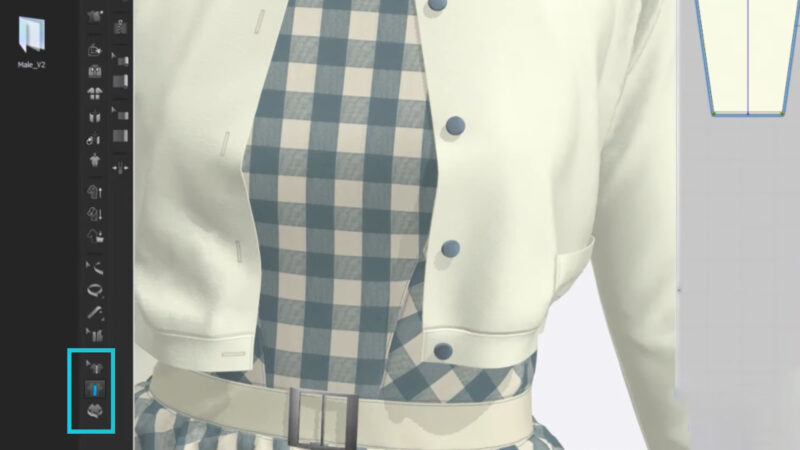
CLO 3D is revolutionizing the fashion industry with its 3D garment visualization capabilities, allowing designers to see their creations come to life before they’re even produced.
3D Visualization with CLO 3D
CLO 3D offers a real-time 3D garment visualization tool that allows designers to create, adjust, and finalize designs with unparalleled speed. With its virtual sampling capabilities, designers can reduce the need for physical samples, leading to cost savings and faster time-to-market.
Why CLO 3D Stands Out
- Virtual Sampling: This feature reduces the need for physical prototypes, saving both time and money.
- Real-Time Adjustments: Designers can make changes on the fly and see them reflected immediately in 3D.
10. Vetigraph
Vetigraph is a CAD software specifically designed for the fashion and textile industry, offering a range of tools to streamline the design and production process.
Features of Vetigraph
Vetigraph offers tools for pattern drafting, grading, and automatic marker making. It also provides a digital fabric library, allowing designers to visualize their creations with different textiles. The software’s compatibility with various file formats ensures seamless integration with other industry-standard tools.
Advantages of Using Vetigraph
- Digital Fabric Library: This allows designers to experiment with different textiles without the need for physical samples.
- Compatibility: Vetigraph’s ability to work with various file formats ensures it integrates well with other tools in the design process.
11. Assyst Bullmer
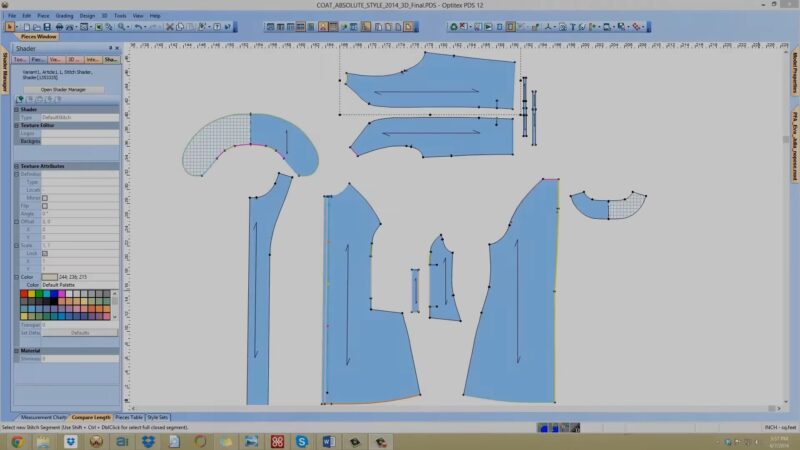
Assyst Bullmer is known for its holistic approach to the fashion design process, integrating various stages from conception to production.
Features of Assyst Bullmer
The software offers tools for pattern design, grading, and marker making. Additionally, it provides 3D visualization capabilities, allowing designers to see their creations in a virtual environment.
Assyst Bullmer also integrates with PLM systems, ensuring a smooth flow of data throughout the design and production process.
Benefits of Using Assyst Bullmer
- 3D Visualization: This feature allows designers to see their creations in a virtual environment, reducing the need for physical samples.
- PLM Integration: Seamless data flow ensures that all departments are on the same page, leading to increased efficiency.
12. Modaris
Modaris is a powerful CAD software by Lectra, designed specifically for pattern making, grading, and prototyping in the fashion industry.
Features of Modaris
Modaris offers a range of tools for pattern creation, grading, and 3D prototyping. Its intuitive interface ensures that designers can easily manipulate patterns, adjust grading, and visualize their designs in 3D.
Why Modaris is a Top Choice
- 3D Prototyping: This feature allows designers to create virtual samples, reducing the need for physical prototypes.
- Intuitive Interface: The software is designed with the user in mind, ensuring a smooth design process.
13. FashionCAD
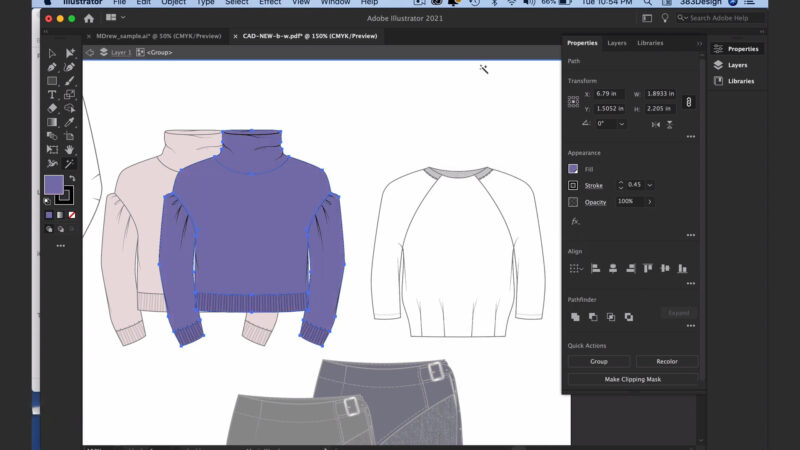
FashionCAD is an integrated suite of software tools designed to automate the fashion design and product development process. Renowned for its adaptability and user-friendly interface, it’s a top choice for both novice designers and seasoned professionals.
Features of FashionCAD
FashionCAD brings to the table tools for drafting, pattern modification, grading, and even 3D visualization. Its unique selling point is the ability to convert 2D patterns into 3D models, offering a realistic representation of the final garment. The software also comes with a built-in fabric and color library, which designers can use to experiment with various looks.
Moreover, FashionCAD supports compatibility with a variety of file formats, ensuring that it easily fits into any design workflow. It also boasts a feature that predicts fabric consumption, helping businesses manage costs efficiently.
Advantages of Using FashionCAD
- 3D Visualization: The ability to convert 2D designs into 3D models gives designers a realistic view of the final product, enabling them to make informed decisions.
- Integrated Library: The built-in fabric and color library allows for endless experimentation, pushing the boundaries of creativity.
- Cost Management: Predictive fabric consumption tools ensure that designers can keep an eye on the budget, making it an invaluable tool for businesses.
FashionCAD is a testament to how technology can seamlessly blend with creativity, offering tools that not only streamline the design process but also enhance the quality of the final product.
FAQ
What is the learning curve for this pattern-making software?
While each software has its unique interface and features, most are designed to be user-friendly. However, the learning curve can vary based on the individual’s familiarity with CAD tools. Many of these software providers offer tutorials, online courses, and customer support to assist new users.
Is there any free or open-source pattern-making software available?
Yes, there are some free and open-source alternatives available, such as Seamly2D and FreeCAD. However, they might not offer the same comprehensive features as the paid versions.
How do these software solutions handle fabric types and textures?
Most advanced pattern-making software have digital fabric libraries or allow users to import fabric textures. This feature helps designers visualize how different fabrics will look in their designs.
Can I integrate these software tools with other design tools I use?
Many of these software solutions offer compatibility with various file formats and can integrate with other design and PLM systems, ensuring a seamless design workflow.
Is cloud storage available for these software solutions?
Some of these software solutions offer cloud storage or are compatible with cloud storage solutions, allowing designers to access their work from anywhere and collaborate with teams remotely.
How often do these software solutions get updated?
Most reputable software providers release regular updates to improve functionality, add new features, and ensure compatibility with the latest operating systems.
Can I customize the software interface to suit my workflow?
Many of these software tools allow users to customize the interface, toolbars, and shortcuts to optimize their workflow.
Final Words
The world of fashion design has evolved dramatically with the advent of digital tools. Pattern-making software has not only streamlined the design process but also opened up new avenues for creativity and precision.
As the fashion industry continues to embrace technology, having the right tools at your disposal becomes imperative. Whether you’re just starting out or looking to upgrade your current software suite, the options listed in this article offer a range of features to cater to every need.
